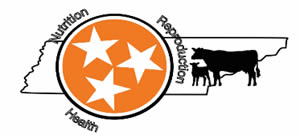
Many beef herds in the United States are housed outdoors with a variety of different types of shelter. As a result, cattle are often exposed to seasonal weather patterns (Fogsgaard 2018). During winter months in the southeast, daily high temperatures are generally above 40℉ and lows below 32℉. Despite these temperatures not generally being considered detrimental to production and higher than northern production areas, the humidity is much higher with days over 80%. Furthermore, yearly rainfall in Tennessee averages more than 50 inches with over 4 inches in January alone. Evaporative loss is the act of wicking heat away from the body through the movement of moisture and air (Young 1981; Schütz 2010). While evaporative heat loss is generally much lower in cattle due to increased humidity during winters in the southeast; cattle may still experience negative effects of evaporative loss. The thermoneutral zone is a range of temperatures in which an animal can maintain appropriate body temperature within normal energy requirements (Kingma et al. 2012). In the event that the environment takes an animal outside of its thermoneutral zone the subsequent stress and immune responses can be detrimental to feed intake and reproduction (Carroll 2012).
It is important to monitor cold stress in cows. During cold periods, cows require more energy to maintain an appropriate internal temperature (Young 1981). Spring calving cows will experience colder temperatures as nutrient requirements of gestation and calf growth are increasing exponentially (Paradis 2017). Also, a significant nutrient deficit can decrease subsequent reproductive performance of the dam, including calving and rebreeding (Pugh 1985). In fall calving herds, December and January marks the point in the breeding season where clean-up bulls will go in and stay until the end of the breeding season. Both temperature and humidity, individually combined, can have negative effects on reproductive efficiency of the bull due to lower semen quality (Llamas-Luceño 2020; Seifi-Jamadi 2020). Additionally, fall calving cows are establishing pregnancy, thus, nutrition and environmental stress must be mitigated to avoid the negative effects of cold stress on reproductive efficiency. Focus on nutritional management will ensure cyclicity during breeding and maximize pregnancy rates as early in the season as possible (Gwazdauskas 1985, Richards 1986). For producers raising breeding stock, cold stress has a much greater impact on younger animals due to the complex interaction between reproductive develop and nutrition (Vince 2018).
When considering prevention of cold stress, it is important to acknowledge the importance of shelter. Though most beef breeds are resilient to extreme weather, cover can provide an additional barrier against both heat and cold stress in serving as a barrier to wind, rain, and sunlight (Schütz 2010). Additionally, nutritional supplementation may be necessary to ensure that each animal’s needs are met, however it is also important to regulate supplementation to avoid over-feeding and the negative effects on performance that come with it (Skinner 1981, Harrison et al. 2021). Cold stress and humidity are relevant threats to beef production and avoiding these stressors helps to maximize reproductive efficiency, as well as growth and development. While these stressors may not be extreme they can be enough to impact herd health and reproductive efficiency.

